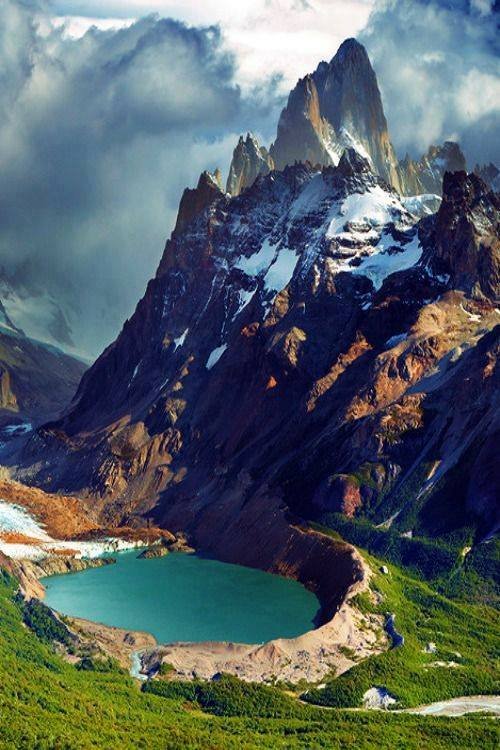
For adventure enthusiasts, Patagonia has reached the "end of the Earth" - nature in its wildest form. The enormous spaces and breathtaking landscapes made Patagonia a vogue destination: a Swiss for nothing.
The wind followed me all over Patagonia. He sank my sinuses, and sometimes my jeep skidded on the gravel of the roads like on the ice. The birds flew away. Trees were growing horizontally. The wind was a living being. It could be violent; drilling the windows of the windows or spraying dust spouts, rising like miniature tornadoes above the smooth and arid step. On a plateau, over the Santa Cruz River Valley, I got out of the jeep to take a picture; a gust of wind blew my door shut with such violence that the two hinges that secured it from the chassis broke. Sometimes it could be delicate, like touching a flake. On a farm near the Valdès Peninsula, on the Atlantic coast, I watched the wind swallow a piece of paper, moving it in circles above the earth like a magnet that rotates a bearing. In Puerto Deseado, I could not sleep for a whole night because of the wind, which turned the hotel into an unleashed orchestra. The doors shuddered, punching like drums. A hole beneath the corrugated roof took off a flute. The bathroom vent grilled like a spear. All night, the wind sang the wild symphony, jumping from a delicate pianissimo to a frantic crescendo.
Until recently, this immense, less populous region of southern southern South America was synonymous with isolation - the finest terrae, the farthest end of the earth. Never a country or a state, rather a hard-to-define region, shared between Chile and Argentina, Patagonia generally means any area south of Río Colorado and Rio Bio-Bio's eastern sector. There is, however, no shared opinion of Patagonian identity, and everyone I met had different ideas about this place. "Patagonia," said a sheep farmer in the North of the Country of Fire, picking up a hot piece of lamb's roast - it's wherever you can eat that! "
Due to its isolation and inaccessibility, Patagonia has always been a place of myths and legends, just like Timbuktu or Shangri-la. British explorer and writer Bruce Chatwin believed he found the origins of the unicorn myth in a cave painting in southwest Patagonia. (It was actually huemul, fork-fork, a rare Patagonian species). Today, however, new myths emerge: for most people, Patagonia is not a place, but a clothing company. For adventurers, it is the "end of the earth", the nature in its wildest form. For large corporations, it is a deposit of natural resources: oil, gas, gold or fish. And as globalization attracts more and more regions in its orbit, and communications overcome distances, Patagonia transcends myths to the center of the 21st century.
All this movement is fueling a new sense of regional pride; on my journeys I have often heard the phrase NYC - nacido y criado, which means "Patagonian born and raised". In the May 2003 elections, Nestor Kirchner, governor of Santa Cruz Province, became president of Argentina - the first Patagonian in this position - to further strengthen the region's confidence in its own strength. Of all the changes taking place in Patagonia, none have had a greater impact than land-change land use and land use, which almost led to the bankruptcy of huge sheep or estancian farms on the Argentinian plateau. Spread over nearly 2,400 kilometers, between Río Colorado in the north and Fire Country in the south, this giant steppe is the heart of Patagonia. Culture and its economy have been built on sheep. But since the 1970s, the dramatic decline in wool prices and desertification caused by overcrowding have knelt down this industry. Hundreds of estancias went bankrupt, and others were sold to rich strangers. Almost a sixth of the Argentine Patagonia now belongs to a number of 350 foreign landlords, many of them American.
"Before, we had about 12,000 sheep, 90 horses and a few dairy cows," says Joan "Petty" Nauta, with a Scottish accent, while drinking our tea in Estancia Telken's kitchen next to the town of Perito Moreno in the province of Santa Cruz. With a surface of Romania, but with a population of only 200,000, Santa Cruz is the historical epicenter of the oat tree in Patagonia. "We now have less than 3,000."
Set in the shelter of a hilly crescent from the Andes, Telken is, like any estancia in Patagonia, a green oasis in the bead of a wild desert. It took me two days of bruises and slippings through the pebbles of gravel roads to get to Puerto Madryn,

what a tremendous height!
i hope one day i get to visit this place it looks incredible
thank you for sharing
and me thx i love nature
@OriginalWorks
To call @OriginalWorks, simply reply to any post with @originalworks or !originalworks in your message!
thx a lot
Patagonia has been on my travel list and I hope to visit one day
in mine great place
Beautiful...
yupii
0.56% @pushup from @ionutciobanu
thx but i havr other not upvote any prbleme?
Which one? What was url and amount?
the @boomerang whitepaper.This post has received a 0.92 % upvote from @boomerang thanks to: @ionutciobanu@boomerang distributes 100% of the SBD and up to 80% of the Curation Rewards to STEEM POWER Delegators. If you want to bid for votes or want to delegate SP please read
i love you
the best service ever
This place is so breathtaking. I was hoping to travel here this summer.
Beautiful i like landscape